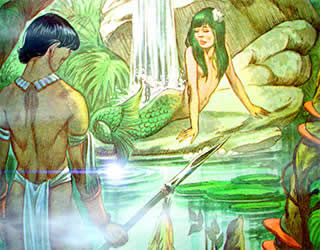Iara,
also spelled Uira or Yara, is the name of a figure from Brazilian mythology
based on ancient Tupi and Guaraní mythology. The word derives from Old Tupi yîara,
i.e. y + îara (water + lord/lady), i.e. lady of the lake (water queen). She is
seen either as a water nymph, siren or as a mermaid depending upon the context
of the story told about her. The Brazilian town of Nova Olinda claims the Cama
da Mãe D’água as the home of Iara.
Iara
was a beautiful young woman, sometimes described as having green hair and light
skin, connected to a freshwater water body (the Tupi word y did not have a
distinct meaning, being used in general for any such place) who would sit on a
rock by the river combing her hair or dozing under the sun. When she felt a man
around she would start to sing gently to lure him. Once under the spell of the
Iara a man would leave anything to live with her underwater forever, which was
not necessarily a bad thing, as she was pretty and would cater for all needs of
her lover for the rest of his life.
Iaras
are immortal (like the nymphs of Greek mythology), but her lovers do age and
die, which means that they live most of eternity alone.

The
legend of the Iara was one of the usual explanations for the disappearance of
those who ventured alone in the jungle.
Iara
(or Yara) is also a very popular female name in Brazil.
The
Iara is similar in nature to several other female figures of folklore from other
regions such as La Llorona from Mexico and the Southwestern United States, the
Columbian creatures La Patasola and the Tunda and the Deer Woman of North
America. All are females who at times function as sirens leading men to their
death.
In
the 1969 film version of the novel Macunaíma, the protagonist of the same name
meets his death at the hands of an Iara. He embraces her eagerly and sees too
late the blowhole in the back of her neck that gives her away as the creature
she is and not the beautiful woman he mistook her for.
This
physical deformity marking an otherwise perfect woman is a common theme among
siren figures in the Americas but it is usually one of the feet. Deer Woman has
hooves for feet, La Patasola and the Tunda have deformed feet and La Llorona is
often said to have no feet by those who see her.